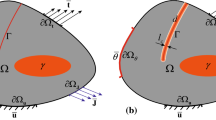Abstract
When using local fracture criteria, it is usually assumed that a fracture begins when the maximum equivalent stress reaches the limit value at least at one point of the body. However, under conditions of an inhomogeneous stress state, it is suitable to use nonlocal failure criteria which take into account the nonuniformity of the stress distribution and yield limit load estimates that are closer to the experimental data. An algorithm of the joint use of the boundary element method (in the version of the fictitious stress method) and gradient fracture criterion for calculations of the strength of plane construction elements is composed. The computations are carried out using a program written in FORTRAN. Results on the limit loading obtained numerically and analytically based on the local criterion of maximum stress and nonlocal fracture criteria (gradient criterion and Nuismer criterion) are compared both among themselves and with the experimental data on the failure of ebonite specimens. A brittle fracture of ebonite cylinders with a hole under diametric compression is studied experimentally. It is shown that nonlocal criteria lead to limit loading values which are closer to the experimental ones than the local criterion. The estimates obtained by the local maximum stress criterion are significantly less than the experimental ones. The estimates found for limit loads by the Nuismer criterion are greater than similar ones determined by the local criterion; nevertheless, they are less than the experimental ones, while the limit load values according to the gradient criterion are closest to the experimental values. Using the nonlocal fracture criteria in designing constructions with stress concentrators will allow us to increase the design values of the limit loads.
Similar content being viewed by others
References
Mellor, M. and Hawkes, I., Measurement of tensile strength by diametral compression of discs and annuli, Eng. Geol., 1971, vol. 5, no. 3, pp. 173–225. https://doi.org/10.1016/0013-7952%2871%2990001-9
Efimov, V.P., Gradient approach to determination of tensile strength of rocks, J. Min. Sci., 2002, vol. 38, no. 5, pp. 455–459. https://doi.org/10.1023/A:1023935731784
Legan, M.A., Brittle fracture of structures elements with stress concentrators, Vestn. Novosib. Gos. Univ., Ser. Mat. Mekh. Inform., 2013, vol. 13, no. 3, pp. 70–76.
Efimov, V.P., Rock tests in nonuniform fields of tensile stresses, J. Appl. Mech. Tech. Phys., 2013, vol. 54, no. 5, pp. 857–865. https://doi.org/10.1134/S0021894413050192
Efimov V.P. Tensile strength of rocks by test data on disc-shaped specimens with a hole drilled through the disc center, J. Min. Sci., 2016, vol. 52, no. 5, pp. 878–884. https://doi.org/10.1134/S1062739116041334
Frocht, M.M., Photoelasticity, New York: Wiley, 1948, vol. 2.
Chen, C.S., Pan, E., and Amadei, B., Fracture mechanics analysis of cracked discs of anisotropic rock using the boundary element method, Int. J. Rock Mech. Min., 1998, vol. 35, no. 2, pp. 195–218. https://doi.org/10.1016/S0148-9062%2897%2900330-6
Ke, C.-C., Chen, C.-S., and Tu, C.-H., Determination of fracture toughness of anisotropic rocks by boundary element method, Rock Mech. Rock Eng., 2008, vol. 41, no. 4, pp. 509–538. https://doi.org/10.1007/s00603-005-0089-9
Crouch, S.L. and Starfield, A.M., Boundary Element Methods in Solid Mechanics, London: Jeorge Allen and Unwin, 1983.
Legan M.A., Correlation of local strength gradient criteria in a stress concentration zone with linear fracture mechanics, J. Appl. Mech. Tech. Phys., 1993, vol. 34, no. 4, pp. 585–592. https://doi.org/10.1007/BF00851480
Legan M.A., Determination of the breaking load and the position and direction of a fracture using the gradient approach, J. Appl. Mech. Tech. Phys., 1994, vol. 35, no. 5, pp. 750–756. https://doi.org/10.1007/BF02369556
Banerjee, P.K. and Butterfield, R., Boundary Element Methods in Engineering Science, New York: McGraw-Hill, 1981.
Whitney, J.M. and Nuismer, R.J., Stress fracture criteria for laminated composites containing stress concentrations, J. Compos. Mater., 1974, vol. 8, no. 3, pp. 253–265. https://doi.org/10.1177/002199837400800303
Novozhilov, V.V., Theory of Elasticity, Amsterdam: Elsevier, 1961.
Sheremet, A.S. and Legan, M.A., Application of the gradient strength criterion and the boundary element method to a plane stress-concentration problem, J. Appl. Mech. Tech. Phys., 1999, vol. 40, no. 4, pp. 744–750. https://doi.org/10.1007/BF02468453
Novikov, N.V. and Maistrenko, A.L., Crack resistance of crystalline and composite superhard materials, Mater. Sci., 1984, vol. 19, no. 4, pp. 298–304. https://doi.org/10.1007/BF00720787
Author information
Authors and Affiliations
Corresponding author
Additional information
Original Russian Text © M.A. Legan, V.A. Blinov, 2018, published in Vychislitel’naya Mekhanika Sploshnykh Sred, 2017, Vol. 10, No. 3, pp. 332–340.
Rights and permissions
About this article
Cite this article
Legan, M.A., Blinov, V.A. Stress Analysis for Perforated Cylinders with Combined Use of the Boundary Element Method and Nonlocal Fracture Criteria. J Appl Mech Tech Phy 59, 1227–1234 (2018). https://doi.org/10.1134/S002189441807009X
Received:
Accepted:
Published:
Issue Date:
DOI: https://doi.org/10.1134/S002189441807009X




